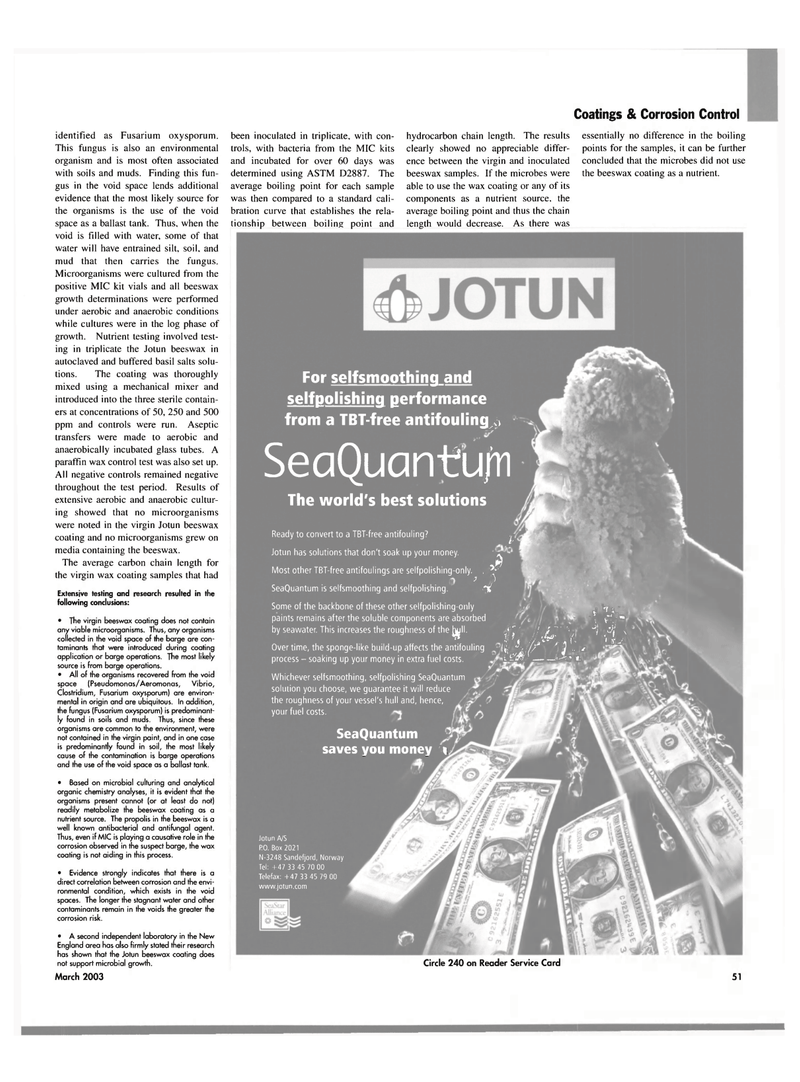
Page 51: of Maritime Reporter Magazine (March 2003)
Read this page in Pdf, Flash or Html5 edition of March 2003 Maritime Reporter Magazine
Coatings & Corrosion Control identified as Fusarium oxysporum.
This fungus is also an environmental organism and is most often associated with soils and muds. Finding this fun- gus in the void space lends additional evidence that the most likely source for the organisms is the use of the void space as a ballast tank. Thus, when the void is filled with water, some of that water will have entrained silt, soil, and mud that then carries the fungus.
Microorganisms were cultured from the positive MIC kit vials and all beeswax growth determinations were performed under aerobic and anaerobic conditions while cultures were in the log phase of growth. Nutrient testing involved test- ing in triplicate the lotun beeswax in autoclaved and buffered basil salts solu- tions. The coating was thoroughly mixed using a mechanical mixer and introduced into the three sterile contain- ers at concentrations of 50, 250 and 500 ppm and controls were run. Aseptic transfers were made to aerobic and anaerobically incubated glass tubes. A paraffin wax control test was also set up.
All negative controls remained negative throughout the test period. Results of extensive aerobic and anaerobic cultur- ing showed that no microorganisms were noted in the virgin Jotun beeswax coating and no microorganisms grew on media containing the beeswax.
The average carbon chain length for the virgin wax coating samples that had
Extensive testing and research resulted in the following conclusions: • The virgin beeswax coating does not contain any viable microorganisms. Thus, any organisms collected in the void space of the barge are con- taminants that were introduced during coating application or barge operations. The most likely source is from barge operations. • All of the organisms recovered from the void space (Pseudomonas/Aeromonas, Vibrio,
Clostridium, Fusarium oxysporum) are environ- mental in origin and are ubiquitous. In addition, the fungus (Fusarium oxysporum) is predominant- ly found in soils and muds. Thus, since these organisms are common to the environment, were not contained in the virgin paint, and in one case is predominantly found in soil, the most likely cause of the contamination is barge operations and the use of the void space as a ballast tank. • Based on microbial culturing and analytical organic chemistry analyses, it is evident that the organisms present cannot (or at least do not) readily metabolize the beeswax coating as a nutrient source. The propolis in the beeswax is a well known antibacterial and antifungal agent.
Thus, even if MIC is playing a causative role in the corrosion observed in the suspect barge, the wax coating is not aiding in this process. • Evidence strongly indicates that there is a direct correlation between corrosion and the envi- ronmental condition, which exists in the void spaces. The longer the stagnant water and other contaminants remain in the voids the greater the corrosion risk. • A second independent laboratory in the New
England area has also firmly stated their research has shown that the Jotun beeswax coating does not support microbial growth.
March 2003 been inoculated in triplicate, with con- trols, with bacteria from the MIC kits and incubated for over 60 days was determined using ASTM D2887. The average boiling point for each sample was then compared to a standard cali- bration curve that establishes the rela- tionship between boiling point and hydrocarbon chain length. The results clearly showed no appreciable differ- ence between the virgin and inoculated beeswax samples. If the microbes were able to use the wax coating or any of its components as a nutrient source, the average boiling point and thus the chain length would decrease. As there was essentially no difference in the boiling points for the samples, it can be further concluded that the microbes did not use the beeswax coating as a nutrient.
For selfsmoothing and selfpolishing performance from a TBT-free antifouling a
SeaQuantu/n
The world's best solutions
Ready to convert to a TBT-free antifouling?
Jotun has solutions that don't soak up your money.
Most other TBT-free antifoulings are selfpolishing-only.
SeaQuantum is selfsmoothing and selfpolishing. } £
J ' 1 4
Some of the backbone of these other selfpolishing-only paints remains after the soluble components are absorbed by seawater. This increases the roughness of the J^ll.
Over time, the sponge-like build-up affects the antifouling process - soaking up your money in extra fuel costs.
Whichever selfsmoothing, selfpolishing SeaQuantum solution you choose, we guarantee it will reduce the roughness of your vessel's hull and, hence, your fuel costs.
SeaQuantum saves you money i i' f ' it .L y lAwTAr:,
V(. • k I <
L L'fo * t. i ' V .„ I V .
J, (
I 1 \
I r J
Jotun A/S
R0. Box 2021
N-3248 Sandefjord, Norway
Tel: +47 33 45 70 00
Telefax: +47 33 45 79 00 www.jotun.com
Circle 240 on Reader Service Card 51

 50
50

 52
52
